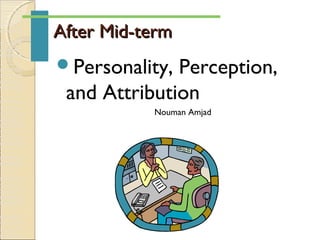
Personality lec 5
- 1. After Mid-termAfter Mid-term Personality, Perception, and Attribution Nouman Amjad
- 2. The Environment • Organization • Work group • Job • Personal life Variables InfluencingVariables Influencing Individual BehaviorIndividual Behavior The Person • Skills & abilities • Personality • Perceptions • Attitudes •Values • Ethics Behavior B =B = ff(P,E)(P,E) B E P
- 3. Propositions ofPropositions of Interactional PsychologyInteractional Psychology Behavior—function of a continuous, multi-directional interaction between person and situation Person—active in process ◦ Changed by situations ◦ Changes situations People vary in many characteristics Two situational interpretations ◦ The objective situation ◦ Person’s subjective view of the situation
- 4. Definition of PersonalityDefinition of Personality Personality - A relatively stable set of characteristics that influences an individual’s behavior
- 5. Personality TheoriesPersonality Theories Trait Theory - understand individuals by breaking down behavior patterns into observable traits Psychodynamic Theory - emphasizes the conscious and unconscious determinants of behavior Humanistic Theory - emphasizes individual growth and improvement Integrative Approach - describes personality as a composite of an individual’s psychological processes
- 6. Big Five Personality TraitsBig Five Personality Traits Extraversion Gregarious, assertive, sociable Agreeableness Cooperative, warm, agreeable Conscientiousness Hardworking, organized, dependable Emotional stability Calm, self-confidant, cool Openness to experience Creative, curious, cultured Sources: P. T. Costa and R. R. McCrae, The NEO-PI Personality Inventory (Odessa, Fla.: Psychological Assessment Resources, 1992); J. F. Salgado, “The Five Factor Model of Personality and Job Performance in the European Community,” Journal of Applied Psychology 82 (1997): 30-43.
- 7. Personality CharacteristicsPersonality Characteristics in Organizationsin Organizations Locus of Control Internal External I control what happens to me! People and circumstances control my fate!
- 8. Personality CharacteristicsPersonality Characteristics in Organizationsin Organizations Self-Efficacy - beliefs and expectations about one’s ability to accomplish a specific task effectively Sources of self-efficacy ◦ Prior experiences and prior success ◦ Behavior models (observing success) ◦ Persuasion ◦ Assessment of current physical & emotional capabilities
- 9. Personality CharacteristicsPersonality Characteristics in Organizationsin Organizations Self-Esteem Feelings of Self Worth Success tends to increase self-esteem Failure tends to decrease self-esteem
- 10. Personality CharacteristicsPersonality Characteristics in Organizationsin Organizations High self-monitors ◦ flexible: adjust behavior according to the situation and the behavior of others ◦ can appear unpredictable & inconsistent Low self-monitors ◦ act from internal states rather than from situational cues ◦ show consistency ◦ less likely to respond to work group norms or supervisory feedback Self-Monitoring Behavior based on cues from people & situations
- 11. Who Is Most Likely to . . .Who Is Most Likely to . . . Low-self monitors High-self monitors Get promoted Change employers Make a job-related geographic move Accomplish tasks, meet other’s expectations, seek out central positions in social networks Self-promote Demonstrate higher levels of managerial self-awareness; base behavior on other’s cues and the situation
- 12. Personality CharacteristicsPersonality Characteristics in Organizationsin Organizations Positive Affect - an individual’s tendency to accentuate the positive aspects of oneself, other people, and the world in general Negative Affect - an individual’s tendency to accentuate the negative aspects of oneself, other people, and the world in general
- 13. Personality CharacteristicsPersonality Characteristics in Organizationsin Organizations A strong situation can overwhelm the effects of individual personalities by providing strong cues for appropriate behavior
- 14. Personality CharacteristicsPersonality Characteristics in Organizationsin Organizations Strong personalities will dominate in a weak situation
- 15. How is Personality Measured?How is Personality Measured? Projective Test - elicits an individual’s response to abstract stimuli Behavioral Measures - personality assessments that involve observing an individual’s behavior in a controlled situation Self-Report Questionnaire - assessment involving an individual’s responses to questions Myers-Briggs Type Indicator (MBTI) - instrument measuring Jung’s theory of individual differences.
- 16. Myers-Briggs Type IndicatorMyers-Briggs Type Indicator Based on Carl Jung’s work ◦ People are fundamentally different ◦ People are fundamentally alike ◦ People have preference combinations for extraversion/introversion, perception, judgment Briggs & Myers developed the MBTI to understand individual differences
- 17. MBTI PreferencesMBTI Preferences Preferences Represents Extraversion Introversion How one re-energizes Sensing Intuiting How one gathers information Thinking Feeling How one makes decisions Judging Perceiving How one orients to the outer world
- 18. Social Perception - interpreting information about another person Social PerceptionSocial Perception Barriers • Selective perception • Stereotyping • First-impression error • Projection • Self-fulfilling prophecies
- 19. Social Perception - interpreting information about another person Social PerceptionSocial Perception Perceiver Characteristics • Familiarity with target • Attitudes/Mood • Self-Concept • Cognitive structure Target Characteristics • Physical appearance • Verbal communication • Nonverbal cues • Intentions Situational Characteristics • Interaction context • Strength of situational cues Barriers
- 20. Impression ManagementImpression Management Impression Management - process by which individuals try to control the impression others have of them ◦ Name dropping ◦ Appearance ◦ Self-description ◦ Flattery ◦ Favors ◦ Agreement with opinion
- 21. Attribution TheoryAttribution Theory Attribution theory - explains how individuals pinpoint the causes of their own behavior or that of others Information cues for attribution information gathering ◦ consensus ◦ distinctiveness ◦ consistency
- 22. Attribution BiasesAttribution Biases Fundamental Attribution Error - tendency to make attributions to internal causes when focusing on someone else’s behavior Self-serving Bias - tendency to attribute one’s own successes to internal causes and one’s failures to external causes